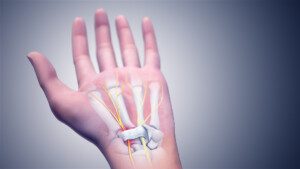
Carpal tunnel syndrome can cause hands to feel cold, and it can also cause discomfort in the hands and even forearms.
In fact, the symptom of cold hands can precede any symptoms of actual pain or aching.
“Very few patients have significant pain,” says Dr. John T. Knight, MD, an L.A.-based hand and wrist orthopedic surgeon and director of the Hand and Wrist Institute at the D.I.S.C. Sports and Spine Center. He continues, “The most common symptoms are tingling, numbness, and aching discomfort.”
However, it’s not uncommon for carpal tunnel syndrome to awaken somebody in the middle of the night by causing pain.
This is because during sleep, a person may take on certain body positions that are conducive to putting the wrist in a flexed position, that is, bent so that the angle between the palm and underside of the forearm is decreased.
Sometimes the angle of wrist flexion can be close to 100 degrees, while the person is fast asleep, unaware that this wrist flexion is putting pressure on the median nerve.
Pressure on the median nerve is what causes carpal tunnel symptoms.

Carpal tunnel syndrome. Scientific Animations
It is along this nerve, which begins at the neck, that electrochemical signals travel that allow your thumb and fingers (except pinky) to move, as well as to feel.
In carpal tunnel syndrome, the median nerve is pressed upon at the wrist by a band of ligamentous tissue.
This nerve compression interrupts the signals coming from the brain for movement, or coming from the receptor neurons in the fingers for touch and feel, hence, why classic symptoms of carpal tunnel syndrome are tingling, numbness and weakness involving the fingers and hand.
Cold hands can be a symptom of carpal tunnel syndrome as well.
Dr. Knight explains, “Coldness in the hands is similar to tingling and is due to the pressure on the nerve and temporary decrease in circulation loss to the nerve.”
Surgery to correct carpal tunnel syndrome is recommended when conservative treatments (e.g., wrist splinting, cortisone injections, hand exercises) have failed.
Traditionally, surgery involves an incision about an inch long, stitches, and bulky restrictive bandages that must be worn for 2-3 weeks after surgery, and rehabilitation can take up to three months.
Dr. Knight specializes in stitchless endoscopic carpal tunnel release, which involves only a 1 cm incision, no stitches, much less surgical pain, and a much faster recovery time. Watch the video below where he explains the procedure.

 Dr. Knight
Dr. Knight









